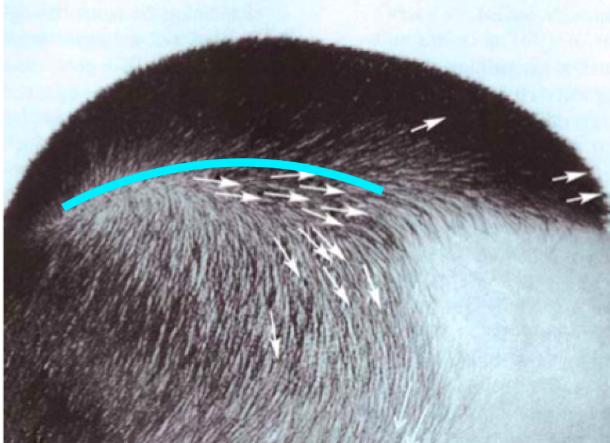Defining Hair Transplant Scalp Regions: The Lateral Crease
Throughout many of these articles on hair restoration, I am trying to open up to you the reader the technical terms that I use in my day-to-day discussions and thoughts. This article will focus on one particular region of the scalp, the lateral crease. The lateral crease may be more colloquially defined as the line where one parts one’s hair. It is the transition from the midscalp to the lateral hump, or put another way from the central hair to the temple hair. Anteriorly, the lateral crease blends with the part at the hairline where the temple hair meets the hairline hair. Posteriorly, the lateral crease ends where the crown begins, splitting down and outward where the lateral hump fades and splitting inward and across at the vertex transition point. If these other related landmarks are not clear in your head, I would encourage you to review the related articles on these scalp terms to better understand them.

The light blue line shows the lateral crease. The white arrows show the direction of the hair angles in the lateral hump (below), in the central midscalp (above) and along the lateral crease as well.
The hair angles at the lateral crease go straight forward without any splaying rightward or leftward. Just medial (toward the nose side) the hair angles can be directed inward a bit or remain straight, and just lateral (toward the ear side) the hair angles start to fall downward toward the ear as they are part of the previously mentioned lateral hump. The lateral crease is important as an anatomic landmark for a few reasons. First, it is important to understand it as a transition zone between two scalp regions: the midscalp and the lateral hump. With that idea, the hairs start to change angles as one enters the lateral hump from the midscalp. Second, especially when it concerns the side where the person parts his hair, the lateral crease is fully exposed and open as hairs on either side are parted to opposing directions. Accordingly, the lateral crease on the part side plays a pivotal area to add further density so as to limit the baldness that can appear when the hair is splayed here. Accordingly, the lateral crease can be a very important area to transplant with sufficient density to achieve the desired aesthetic outcomes during a hair-transplant procedure.
Samuel M. Lam, MD, FACS is a board certified hair restoration surgeon in Dallas, Texas. To learn more about Dr Lam’s hair transplant procedures please visit our website hairtx.com or call 972-312-8105 to schedule a consultation.




